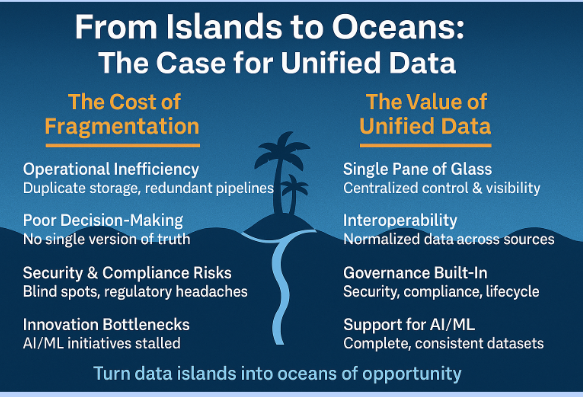
Enterprises today are swimming in data — yet somehow, most of them are still thirsty for insight. Every CIO I speak with knows the paradox: We’ve never had more data, yet we’ve never struggled more to make sense of it. The culprit is data fragmentation. Information is scattered across on-prem systems, multiple clouds, SaaS platforms, and even at the edge. The result? Instead of a single, navigable ocean of information, organizations are stuck with disconnected islands of data.
It’s a problem that kills efficiency, undermines security, and stalls digital transformation. And unless enterprises tackle it head-on with unified data services platforms, they’ll find themselves lost at sea.
How We Got Here
This fragmentation didn’t happen overnight. It’s the by-product of choices and shifts that made sense at the time:
- Multi-Cloud Adoption: Enterprises embraced best-of-breed services from AWS, Azure, Google Cloud, and others. The unintended consequence? Workloads and data are scattered across incompatible ecosystems.
- SaaS Explosion: Every department brought in its own system of record — Salesforce for sales, Workday for HR, ServiceNow for IT, the list goes on. Each became its own island.
- Edge & IoT Growth: Data is increasingly created at the edge — in factories, hospitals, retail stores and smart devices — but rarely integrated back into the enterprise core.
- Legacy Baggage: Decades-old systems still hold mission-critical data. Migrating them is risky and costly, so they remain disconnected from modern analytics platforms.
The result is a patchwork quilt of data sources that don’t align, integrate or talk to each other.
The Cost of Fragmentation
Let’s be clear: Fragmentation isn’t just an inconvenience. It’s a tax on your business.
- Operational Inefficiency: Duplicate storage, redundant pipelines and wasted compute cycles drive up costs. Enterprises spend more on infrastructure but get less value.
- Poor Decision-Making: Without a single version of truth, executives make decisions based on partial or outdated data. That’s not just inefficient — it’s dangerous.
- Security & Compliance Risks: Blind spots make it impossible to enforce governance consistently. Data left in shadow systems is a breach waiting to happen, not to mention a compliance nightmare.
- Innovation Bottlenecks: AI and machine learning initiatives rely on clean, accessible, unified data. Fragmentation turns what should be accelerators into roadblocks.
Fragmentation isn’t just a technical debt — it’s a strategic liability.
The Case for Unified Data Services Platforms
This is where unified data services platforms come in. These aren’t just storage solutions; they’re enterprise-wide systems designed to turn fragmented data into a coherent whole.
- Single Pane of Glass: They give IT and business leaders centralized visibility and control across clouds, on-premises and edge systems.
- Interoperability: They normalize data across disparate systems through APIs and connectors, breaking down silos without requiring wholesale migrations.
- Governance Built-In: Security, compliance and lifecycle management are embedded at the platform level, not bolted on after the fact.
- Performance & Cost Optimization: Smart policies move and store data where it makes the most sense — balancing performance, compliance and cost.
- AI-Ready Data: Unified platforms are the foundation for AI/ML pipelines, ensuring models are trained on complete, accurate and consistent datasets.
Put simply: Unified platforms turn islands of data into oceans of opportunity.
Challenges in Building Unified Platforms
Of course, it’s not easy. Enterprises face real challenges:
- Vendor Lock-In: Proprietary ecosystems don’t always play nicely with others.
- Complexity at Scale: Petabytes of data, billions of files and thousands of sources aren’t trivial to manage.
- Organizational Silos: Departments often treat data as turf, hoarding access rather than sharing it.
- Skills Gap: IT teams need expertise in multi-cloud, edge, and governance — often all at once.
These aren’t reasons to avoid the problem. They are reasons to tackle it with urgency.
Shimmy’s Take: From Islands to Oceans
I like to think of data silos as islands. Each one may be valuable on its own, but collectively, they’re disconnected, fragmented and hard to navigate. Enterprises don’t need more islands. They need oceans — vast, unified expanses of data where insights can flow freely, securely and reliably.
And let’s be clear: Unified data isn’t just a technology issue. It’s a cultural shift. Organizations need to stop treating data as departmental property and start treating it as a shared strategic asset. The oceans metaphor isn’t just poetic — it’s practical. Oceans sustain life. Unified data sustains digital transformation.
What IT Leaders Should Do Now
For IT leaders, the path forward is clear:
- Audit Fragmentation: Map where your data lives, how it flows and who owns it. You can’t fix what you don’t know.
- Prioritize Governance: Make security, compliance and privacy non-negotiable in your data strategy.
- Push Vendors for Interoperability: Demand open standards and APIs. Don’t buy into platforms that lock you down.
- Invest in Platforms That Deliver Business Value: Go beyond storage. Choose systems that support analytics, AI and real-time decision-making.
- Foster a Culture of Sharing: Break down organizational silos. Data must serve the enterprise, not just the department.
Conclusion: Unified Data as the Backbone of Transformation
Digital transformation without unified data is doomed to fail. Enterprises that continue to tolerate fragmentation will find themselves paying more, innovating less, and falling behind competitors who have made the leap.
The future belongs to leaders who recognize that data isn’t just a by-product of business — it is the business. And businesses built on islands will always be fragile.
It’s time to turn those islands into oceans.


